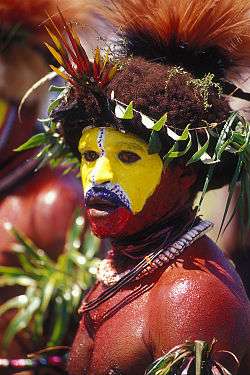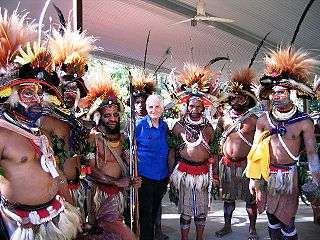Huli people
 Huli wigman, Papua New Guinea | |
| Total population | |
|---|---|
| (Approximately 90,000 [1]) | |
| Regions with significant populations | |
| Southern Highlands districts of Tari, Koroba, Margaraima and Komo, Papua New Guinea. | |
| Languages | |
| Huli language | |
| Religion | |
| Traditional beliefs, Christianity | |
| Related ethnic groups | |
| Indigenous Papuan peoples of West Papua and Papua New Guinea, other Melanesians |
The Huli or Haroli are an indigenous people who live in the Southern Highlands districts of Tari, Koroba, Margaraima and Komo, of Papua New Guinea. They have lived in their current area for about 1000 years. They speak primarily Huli and Tok Pisin; many also speak some of the surrounding languages, and some also speak English. They are one of the largest cultural groups in Papua New Guinea, numbering approximately 90,000.[1]
History
The Huli have lived in their region for 1,000 years and recount lengthy oral histories relating to individuals and their clans. They were extensive travellers (predominantly for trade) in both the highlands and lowlands surrounding their homeland, particularly to the south. The Huli were not known to Europeans until 1935, when they were first contacted by Jack Hides and James O'Malley on their famous Strickland-Purari patrol.
Society
Kinship social structures

The Huli are grouped in clans (hamigini) and subclans (hamigini emene). Clans have residential rights within a specific territory, and membership is based on hereditary descent.
Subclans are smaller groups within the larger clan and are the basic units of Huli society. Subclans operate autonomously, and may make war or peace, or pay indemnities, without consulting the larger clan. Membership of a subclan is usually restricted to those who are directly related to the subclan founder or to another member of the subclan. Huli may belong to several subclans at a time, depending on their kinship and ancestry.
The Huli have an inclusive kinship system. For instance, people who in European cultures are considered half-brothers, half-sisters, and cousins, may all be reckoned as brothers and sisters by the Huli. Also, individuals that other cultures might label their 'aunts' and 'uncles', are seen by the Huli as their 'mothers' and 'fathers'.
Men and women have traditionally lived in separate quarters. Boys go to the men's house or their father's house shortly before the age of puberty. Unmarried men historically lived in large group houses, although this is exceptionally rare nowadays. Traditionally a man's hut was at the center of the village, used for meetings over village activities and sometimes for group sleeping, as well. Women lived in separate huts for them and their families around
Economy

The Huli live by hunting, done primarily by men, and by gathering plants and growing crops, done primarily by women. The men help clear the land, but the rest of cultivation is done by women.
They practice cyclical agriculture, moving to a new location after the soil is exhausted, to allow reforestation and recovery. The women are exceptional farmers, and have adopted many introduced crops, initially sweet potatoes, which have become a staple. More recently, they have cultivated corn, potatoes, cabbage, etc.
The Huli have established business throughout Papua New Guinea.
Warfare
Men went to war to gain more "land, pigs and women."[2] When wearing traditional dress, the men decorate their bodies with colored clay and wear elaborate headdresses for ceremonies. The headdresses were earlier prepared for warfare. From puberty, males grow their hair long in order to make ceremonial wigs. They learn to add to the hair, using pigments, bird feathers, and flowers as ornamental features. Each makes individual headdresses that express the common elements of culture.[2]
Marriage
Huli society is polygynist. Men may take multiple wives but women may only have one husband at a time. Exogamy (where marriage is allowed only outside of a social group) is normal, and marriage between close relatives is forbidden.
Marriages may be arranged, but couples may also choose to marry each other. The man pays a brideprice to the bride and her family, usually pigs or other native livestock. The groom is responsible for building a house for his bride. After marriage, the wife's role is to raise children and care for them, cultivate crops and process them for food, make clothing, and raise the pigs. Boys usually leave their mother's house around age 10 to live with their father. For boys, rites of passage associated with puberty include hunting and time spent in the highlands.
Divorce is not uncommon; the most frequent cause is the wife's failure to bear children. Upon divorce, the husband will attempt to regain the pigs paid to the wife's family at the time of marriage.
References
- 1 2 Modern Loves: The Anthropology of Romantic Courtship & Companionate Marriage By Jennifer S. Hirsch, Holly Wardlow, p.53, 2006
- 1 2 "Huli Wigmen of Tari", Papua New Guinea Scuba Diving Adventure
Sources
- Lomas, G.C.J. (1998). "The Huli People of Papua New Guinea: A study in sociolinguistic change". Retrieved 2006-06-22.
- Allen, M.R. (1967) Male Cults and Secret Initiations in Melanesia. Cambridge University Press, New York.
- Frankel, S. (1980) "I am a Dying Man: Pathology of Pollution," Culture, Medicine and Psychiatry 4, pp. 95–117.
- Glasse, R. (1974) "Masks of Venery: Symbols of Sex Antagonism in the Papua New Guinea Highlands," Homme 14:2, pp. 79–86; 1968; The Huli of Papua, Mouton and Company, Paris.
- Hage, P. and F. Harary. (1981) "Pollution Beliefs in Highland New Guinea," Man 16, pp. 367–375.
- Lomas, G.C.J. (1998). Huli People of Papua New Guinea
- Meshanko, R. (1985) The Gospel Amongst the Huli, Master's Dissertation, Washington Theological Union, Washington, DC.
- Teske, G. (1978) "Christianizing the Sangai," Point 2, pp. 71–102.
Further reading
- "Huli Wigmen of Tari", Papua New Guinea Scuba Diving Adventure
| ||||||||||